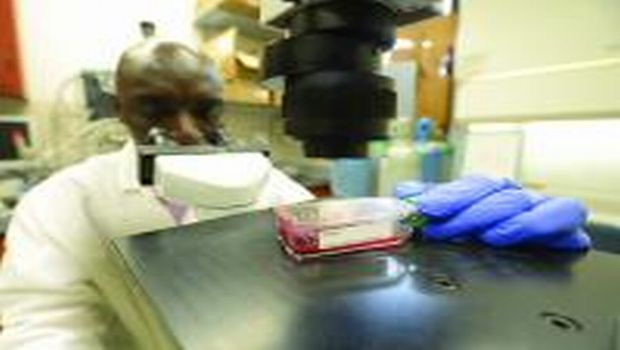Treatment Target is Identified for a Public Health-Risk Parasite
In the developing world, Cryptosporidium parvum has long been the scourge of freshwater. A decade ago, it announced its presence in the United States, infecting over 400,000 people the largest waterborne-disease outbreak in the county's history. Its rapid ability to spread, combined with an incredible resilience to water decontamination techniques, such as chlorination, led the National Institutes of Health (NIH) in the United Sates to add C. parvum to its list of public bioterrorism agents. Currently, there are no reliable treatments for cryptosporidiosis, the disease caused by C. parvum, but that may be about to change with the identification of a target molecule by investigators at the Research Institute of the McGill University Health Centre (RI-MUHC).


This is Dr. Momar Ndao looking at a biological sample in his laboratory at the National Reference Centre for Parasitology, RI-MUHC.
In the developing world, Cryptosporidium parvum has long been the scourge of freshwater. A decade ago, it announced its presence in the United States, infecting over 400,000 people the largest waterborne-disease outbreak in the county's history. Its rapid ability to spread, combined with an incredible resilience to water decontamination techniques, such as chlorination, led the National Institutes of Health (NIH) in the United Sates to add C. parvum to its list of public bioterrorism agents. Currently, there are no reliable treatments for cryptosporidiosis, the disease caused by C. parvum, but that may be about to change with the identification of a target molecule by investigators at the Research Institute of the McGill University Health Centre (RI-MUHC).
The findings of this study have been recently published in the Antimicrobial Agents and Chemotherapy (AAC) journal.
"In the young, the elderly and immunocompromised people such as people infected with HIV/Aids, C. parvum is a very dangerous pathogen. Cryptosporidiosis is potentially life-threatening and can result in diarrhea, malnutrition, dehydration and weight loss," says first author of the study, Dr. Momar Ndao, director of the National Reference Centre of Parasitology (NRCP) at the MUHC and an assistant professor of the Departments of Medicine, Immunology and Parasitology (Division of Infectious Diseases) at McGill University.
The oocysts of C. parvum, which are shed during the infectious stage, are protected from a thick wall that allows them to survive for long periods outside the body as they spread to a new host. C. parvum is a microscopic parasite that lives in the intestinal tract of humans and many other mammals. It is transmitted through the fecal-oral contact with an infected person or animal, or from the ingestion of contaminated water or food. Since the parasite is resistant to chlorine and difficult to filter, cryptosporidiosis epidemics are hard to prevent.
"Most protozoan (single-celled) parasites like C. parvum use enzymes called proteases to escape the body's immune defenses," explains Ndao, who is also a researcher in the Infection and Immunity Axis of the RI-MUHC. "In this study, we were able to identify a protease inhibitor that can block the parasite's ability to circumvent the immune system, and hide in intestinal cells called enterocytes, in order to multiply and destroy the intestinal flora."
The discovery, which was made in collaboration with U.S. researchers, is the first time a molecular target has been found for the control of C. parvum. "The next step will be to conduct human clinical trials to develop an effective treatment for this parasite, which affects millions of people around the world," says Ndao.
The study was supported by the Sandler Foundation, The Montreal General Hospital Foundation (MUHC), MUHC and the Research Institute of the McGill University Health Centre (MUHC).
Our Understanding of Immune Issues Is Evolving: Here Are 5 Reasons Why
October 25th 2024The past 5 years in medicine have seen significant advances in RNA vaccines, understanding immune dysregulation, and improved interspecialty communication, promising better disease eradication and tailored treatments.